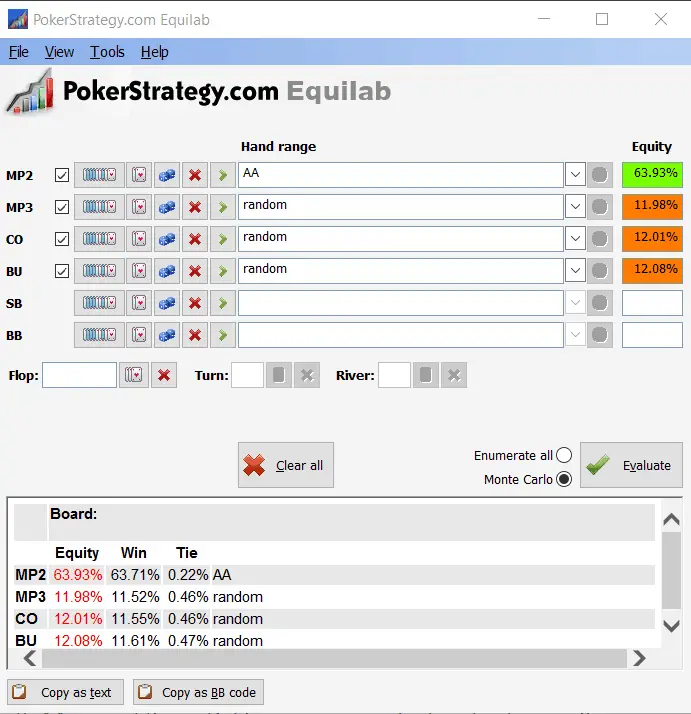
Have you ever witnessed a poker pro playing tighter when more players were involved in the hand? He might have stacked off pre-flop before with pocket Jacks, but then other times he folds and shows he is folding QQ pre-flop? Or it might have been postflop where a tight but a good player was willing to stack off the top set to 4way allin on all hearts and straight possible on the flop? This all might have been due to poker odds being against him or in his favor.
Do poker odds change with more players? Yes, poker odds change with more players involved in the hand. The more players, the less are your chances of winning. Though, this might bring some favorable scenarios for you. Post-flop now, you might be correct to stack off with some hands that would be folded with fewer players involved.
Poker is a lot about maths, and that is exactly what happens with more players. You are now not competing against a single opponent anymore but against more. And each of them has a certain chance to win. This naturally decreases your chances of winning.
Best pre-flop hand, pocket aces, wins around 85% of the time against a random hand in a heads up scenario. I wrote the whole article about it in detail. Odds then decrease for every additional opponent included. We will still remain the highest favorite to win, of course, it just won’t happen that often. Against 3 opponents, we now only have 64% chances to win pre-flop.
Pre-flop odds change with more players
Odds of poker hands changing with more players is not a single thing you should be concerned with when you are making a decision pre-flop. You should think in advance in how your hand does postflop. Many hands are not worth coming along anymore as they could have reverse implied odds. It might cost you a lot of money if you hit a 3rd nut flush only to be up against a nut flush.
The more the action pre-flop, the better hands you will be up against. If the first player is opening around 13% in early position. The second player makes the call with about 11% (he 3bets the very best of hands), and now it is on us to make a call with Jack Ten of hearts. Our equity 3 way is quite low. Opponents will have a lot of hands that dominate ours. We are limited in terms of bluffing multiway postflop as 2 opponents are a lot more likely to hit something good than just one. So we are better off just folding our hand.
If this would be heads up, we could make a call against a straightforward opponent, especially if we see a leak in his stats that we could exploit. With hands that are close between calling and folding, you should really use the help of a HUD. For me, as a professional poker player, a HUD is a must-have in online games. You can read here why poker professionals like to use a HUD here.
Check the pocket aces equity table below (poker hand odds table comparison of different poker hands). You will get an idea of how individual hands and hand groups do against 1, 2, and 3 opponents pre-flop in terms of equity. It includes more realistic scenarios and one example when you are up against a random hand. Most often, the next player that calls has a nice connected hand or a strong range, but not good enough for a squeeze.
| Our hand | One opponent that has JJ | Two Opponents (one JJ, other broadway) | 3 opponents (JJ, broadway, random hand) |
| AA | 81% | 73% | 62.5% |
| 82% | 56.5% | 46% | |
| TT | 18% | 15.3% | 14% |
| broadway | 39.6% | 28.6% | 24.7% |
| T9s | 18.3% | 16.5% | 15.5% |
| 67s | 21.75% | 21.5% | 19.5% |
Poker probabilities change all the time when you add a new variable to it. It can be anything from a position, to how wide an opponent is playing, to the number of opponents you are up against. If you are up against 3 opponents and all in preflop, then you will win less than 2/3 of the time with AA. Sometimes it can be tricky to quickly estimate the odds of poker hands on the fly during play, but with practice and experience, you will get a lot better at it.
Post-flop odds change with more players
With more players, we need to be quite careful with individual hands on the flops. It is not just the odds for our hand that are important. We must account in reverse implied odds. This means if we hit our hand, but it is not the nuts, someone can have a stronger holding. This is a disaster and would cause us to lose a lot of money. Most often, this happens if we hold a draw on the flop that is not to the nuts. Opponents holding a better draw can dominate us in such scenarios.
So next time before you are in an allin multiway scenario on the flop, keep this in mind. It is often better to give up on the flop with a weak draw when up against more opponents. This will save us money in the long term.
Let’s check the following scenarios where we hold a flush draw and overcards in a multiway spot. We can see we do quite bad if any of our opponents have a higher flush draw, and another opponent has a made hand on the flop already. Remember, in multiway all in on the flop having a draw to the nuts is part of the fundamental skill that will save you a lot of money.
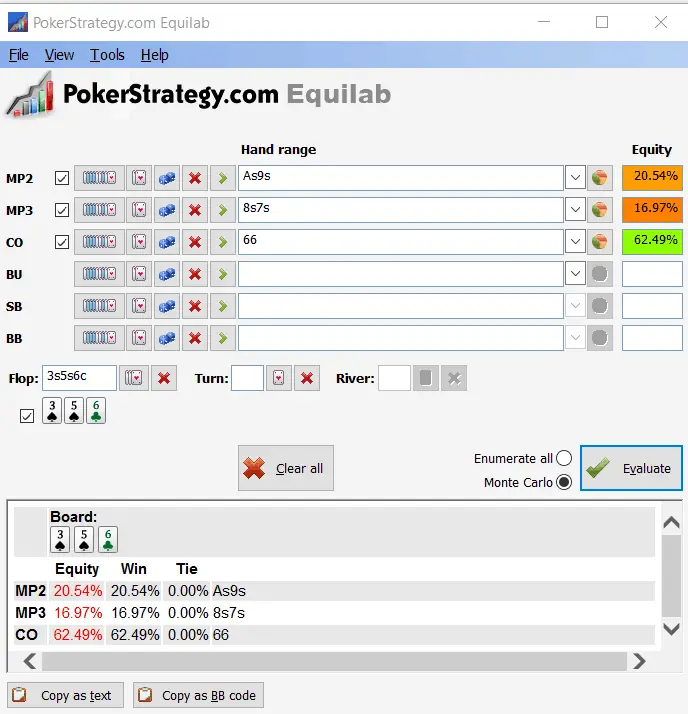
Just like pre-flop, postflop, our odds will also change with more players involved. We shouldn’t bluff post-flop. It is just far too likely someone has hit something, and we are burning money by trying to bluff.
When it’s heads up on the flop, we can try to steal the pot with a continuation bet and putting aggression. If the opponent folds often enough, it will be profitable for us. But when being multiway on the flop, we should avoid these options. We need to focus on the times when we hit the flop and extract the value. If we don’t have a made hand yet, then we need to be sure our odds are good enough to justify staying in the hand or even betting with a strong draw.
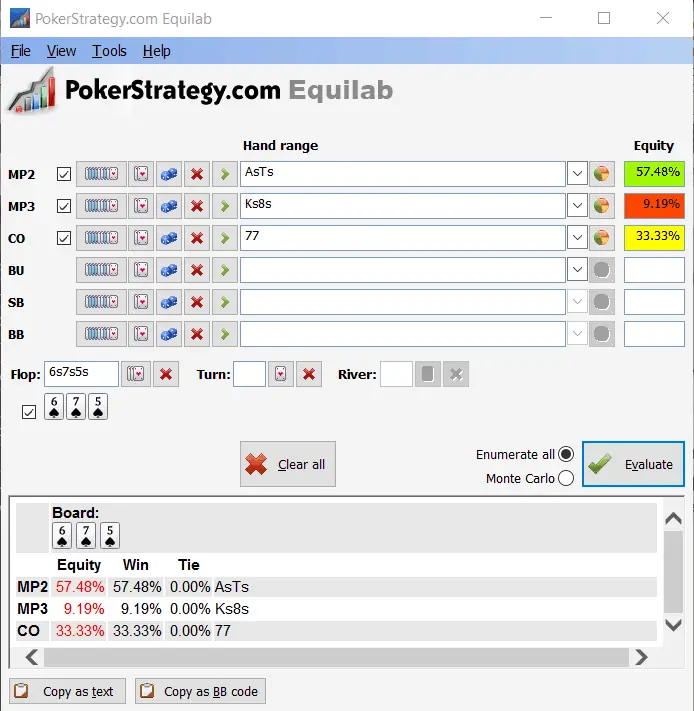
Option to slowplay is not that good anymore more either. It’s far better to value bet with our strong hands and build the pot fast. It is not uncommon we have only slightly more than 50% equity multiway with our nuts on the flop. So even with the nuts on flop, our hands against multiple opponents is vulnerable, and we need to protect it. Top pairs will often call our bets, so will some draws. Then on the turn, if we still have the nuts, we can bet much bigger and stubborn opponents might call us again. This is where nice money is made in poker.
Let’s compare this when we are up against a single opponent. Now we can afford to slowplay and let the opponent hit at least a pair. If the opponent has nothing, we give him a chance to catch on at least a pair or a draw, so we get paid off on at least one street. Moreover, we give him a chance to bluff.
Odds for stacking off on the flop with more players
Often our draws might not be strong enough to stack off on the flop. Even with very strong draws, we will usually have around 40% equity against made hands, which is not enough to put all the chips in the middle unless the pot is big enough already.
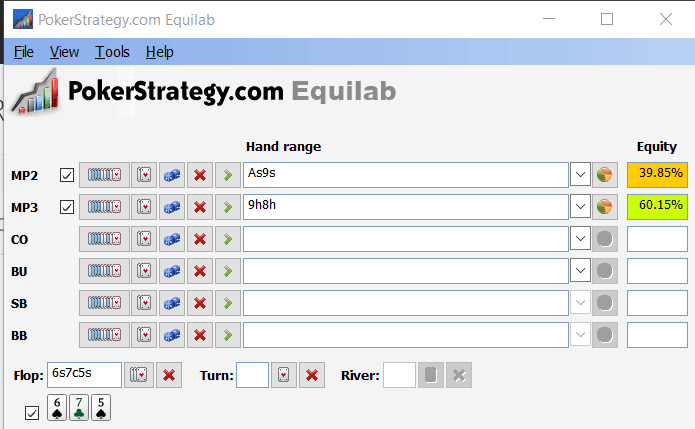
However, in multiway scenarios, our nut draws can become now good enough to stack off on the flop and even make us a little money. At the end of the day, our odds combined with stack to pot ratio determine if our odds are good enough. The pot will be bigger now because of more players involved, which is even better for us with a strong draw. A perfect scenario would be, of course, to have the made hand already, but we will take what we are given. If the pot is big enough, then we might even get worse draws to stack off, and as long as they don’t block our outs, we will do fine.
If we would be only heads up a single opponent, then we are at around 40% equity with our powerful draw. We don’t have the odds to stack off on the flop in a single raised pot.
But when it comes to a multiway scenario and we are up against 3 made hands where neither of them can fold, and we actually would be wrong to fold our hand here. We need 25% to make a breakeven call, and we have more than that. So stacking off in such scenario should make us a little money.
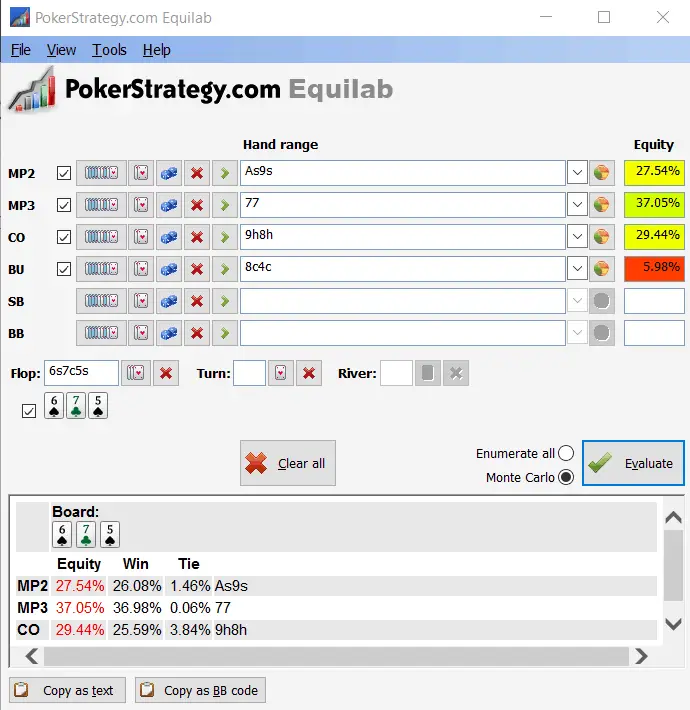
Do Implied odds change post-flop
It is worth noting that sometimes when we don’t have direct odds to call on the flop, and we have a draw, the implied odds can make all the difference in us folding or calling or even raising.
Implied odds simply mean we don’t have the hand yet, and we don’t get an exact price to call a bet with our odds. But once we hit the draw, we will get paid off and make up for a loss of money we made without the proper odds to do so.
The bigger the calling station our opponent is, the better our implied odds will be. If an opponent bets 75% if the pot on all streets all the time and he doesn’t fold, then our open-ended straight draw is good enough to call him to the river. He will call our big bet on the river in many cases, and the times we hit it and get paid off huge will outweigh the times we miss.
This all comes down to math. And having good reads on opponents. I would always make a fold first and second time it happens that someone is barreling at me and would give them credit for a good hand. But when it happens again, I will have my note ready, and I will get paid off eventually. HUDs are a piece of software that will return you the money investment in weeks, if not days, and it’s an essential tool for every serious poker player.
If you play live, then you might wonder if you are allowed to take notes at a poker table. It admittedly sounds weird to have your notebook next to you while playing. Luckily I have you covered. Read about it more in this article.
Poker odds practice
I know it might be hard to calculate the odds on the fly if you are a beginner in poker. You must practice scenarios consistently. Eventually, this will become second nature to you. There are many free programs like Pokerstars Equilab. They will help you immensely to get a feeling for odds and percentages in poker. I use it daily.
Remember, consistency is key. Keep learning something new every day, and surely you will become a better player.




